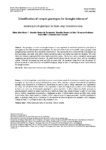Use este identificador para citar ou linkar para este item:
http://www.alice.cnptia.embrapa.br/alice/handle/doc/885401Registro completo de metadados
| Campo DC | Valor | Idioma |
|---|---|---|
| dc.contributor.author | BASTOS, E. A. | pt_BR |
| dc.contributor.author | NASCIMENTO, S. P. do | pt_BR |
| dc.contributor.author | SILVA, E. M. da | pt_BR |
| dc.contributor.author | FREIRE FILHO, F. R. | pt_BR |
| dc.contributor.author | GOMIDE, R. L. | pt_BR |
| dc.date.accessioned | 2011-04-10T11:11:11Z | pt_BR |
| dc.date.available | 2011-04-10T11:11:11Z | pt_BR |
| dc.date.created | 2011-04-08 | pt_BR |
| dc.date.issued | 2011 | pt_BR |
| dc.identifier.citation | Revista Ciência Agronômica, Fortaleza, v. 42, n. 1, p. 100-107, jan./mar. 2011. | pt_BR |
| dc.identifier.uri | http://www.alice.cnptia.embrapa.br/alice/handle/doc/885401 | pt_BR |
| dc.description | The genotypes selection for drought tolerance is very important for world food production, principally in arid regions or sites with irregular rain distribution. The objective of this work was to identify cowpea genotypes with drought tolerance and water stress sensitivity characteristics. Two experiments were carried out with 20 treatments and four replications, one under water deficit during reproductive phase and another one under full irrigation. The water deficit was obtained applying half the water depth required by cowpea. The leaf area index, chlorophyll content, grain components and grain yield were evaluated. The water deficit reduced 20% the leaf area index, 16% the chlorophyll content, 175% the pod number per plant and 60% the grain yield. The genotypes Santo Inácio and Tracuateua-192 present sensitivity to water deficit in soil and BRS-Paraguaçu, Pingo-de-ouro-1-2 and Pingo-de-ouro-2 show behavior for drought tolerance. A seleção de genótipos com tolerância à seca é essencial para a produção de alimentos no mundo, especialmente em regiões de clima árido ou com má distribuição de chuvas. Nesse contexto, o objetivo deste trabalho foi identificar genótipos com características de tolerância e sensibilidade ao estresse hídrico. Foram conduzidos dois experimentos em campo, um sob déficit hídrico durante a fase reprodutiva e outro sob irrigação plena, ambos em um delineamento de blocos ao acaso com 20 tratamentos (genótipos) e quatro repetições. O déficit hídrico foi obtido aplicando-se, aproximadamente, metade da lâmina requerida pela cultura do feijão-caupi. Foram avaliados o índice de área foliar, teor de clorofila, componentes de produção e o rendimento de grãos. O déficit hídrico reduziu em 20% o índice médio de área foliar, 16% o índice médio de clorofila, 175% o número médio de vagens por planta e em 60% a produção de grãos. Os genótipos Santo Inácio e Tracuateua-192 são sensíveis ao déficit de água no solo, enquanto o BRS-Paraguaçu, o Pingo-de-ouro-1-2 e o Pingo-de-ouro-1 são tolerantes à seca. | pt_BR |
| dc.language.iso | eng | eng |
| dc.rights | openAccess | eng |
| dc.subject | Teor de clorofila | pt_BR |
| dc.subject | Índice de área foliar | pt_BR |
| dc.title | Identification of cowpea genotypes for drought tolerance. | pt_BR |
| dc.type | Artigo de periódico | pt_BR |
| dc.date.updated | 2017-09-29T11:11:11Z | pt_BR |
| riaa.ainfo.id | 885401 | pt_BR |
| riaa.ainfo.lastupdate | 2017-09-29 -03:00:00 | pt_BR |
| dc.identifier.doi | 10.1590/S1806-66902011000100013 | pt_BR |
| dc.contributor.institution | EDSON ALVES BASTOS, CPAMN; SEBASTIAO PEREIRA DO NASCIMENTO, IFPI; EVERALDO MOREIRA DA SILVA, BOLSISTA; FRANCISCO RODRIGUES FREIRE FILHO, CPAMN; REINALDO LUCIO GOMIDE, CNPMS. | pt_BR |
| Aparece nas coleções: | Artigo em periódico indexado (CNPMS)  | |
Arquivos associados a este item:
| Arquivo | Descrição | Tamanho | Formato | |
|---|---|---|---|---|
| Identificationcowpea.pdf | 145,73 kB | Adobe PDF |  Visualizar/Abrir |









